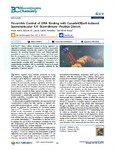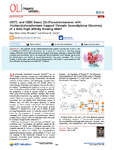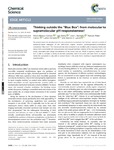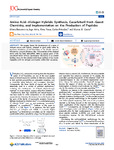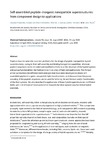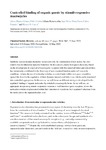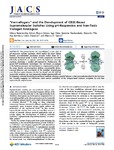Buscar
Mostrando ítems 1-10 de 11
Reversible Control of DNA Binding with Cucurbit[8]uril-Induced Supramolecular 4,4′-Bipyridinium–Peptide Dimers
(American Chemical Society, 2021-03-08)
[Abstract] Many cellular processes in living organisms are regulated by complex regulatory networks, built from noncovalent interactions between relatively few proteins that perform their functions by switching between ...
CB[7]- and CB[8]-Based [2]-(Pseudo)rotaxanes with Triphenylphosphonium-Capped Threads: Serendipitous Discovery of a New High-Affinity Binding Motif
(American Chemical Society, 2022-05-06)
[Abstract] The synthesis of new triphenylphosphonium-capped cucurbit[7]uril (CB[7])- and cucurbit[8]uril (CB[8])-based [2]rotaxanes was achieved by a simultaneous threading-capping strategy. While the use of CB[7] produced ...
Subcellular duplex DNA and G‐quadruplex interaction profiling of a hexagonal PtII metallacycle
(Wiley, 2019-04-19)
[Abstract] Metal‐driven self‐assembly afforded a multitude of fascinating supramolecular coordination complexes (SCCs) with applications as catalysts, host–guest, and stimuli‐responsive systems. However, the interest in ...
Thinking Outside the Blue Box: From Molecular to Supramolecular PH-Responsiveness
(Royal Society of Chemistry, 2019-10-23)
[Abstract] We present herein the development of a new polycationic cyclophane: the “red box”, second in a series of hydrazone-based analogues of the well-known organic receptor cyclobis(paraquat-p-phenylene)cyclophane ...
Amino Acid–Viologen Hybrids: Synthesis, Cucurbituril Host–Guest Chemistry, and Implementation on the Production of Peptides
(American Chemical Society, 2021-12-10)
[Abstract] We present herein the development of a series of viologen–amino acid hybrids, obtained in good yields either by successive alkylations of 4,4′-bipyridine, or by Zincke reactions followed by a second alkylation ...
Self-Assembled Peptide–Inorganic Nanoparticle Superstructures: From Component Design to Applications
(Royal Society of Chemistry, 2020-06-04)
[Abstract] Peptides have become excellent platforms for the design of peptide–nanoparticle hybrid superstructures, owing to their self-assembly and binding/recognition capabilities. Morover, peptide sequences can be encoded ...
The Red Cage: Implementation of pH-Responsiveness Within a Macrobicyclic Pyridinium-Based Molecular Host
(Royal Society of Chemistry, 2021-11-09)
[Abstract] We present herein the implementation of pH-responsiveness into a new polycationic macrobicyclic structure, namely what we have termed the “red cage”. The hydrolytically-stable cryptand-like compound has been ...
Controlled Binding of Organic Guests by Stimuli-Responsive Macrocycles
(Royal Society of Chemistry, 2020-05-12)
[Abstract] Synthetic supramolecular chemistry pursues not only the construction of new matter, but also control over its inherently dynamic behaviour. In this context, classic host–guest chemistry, based on the development ...
Vermellogens and the Development of CB[8]-Based Supramolecular Switches Using pH-Responsive and Non-Toxic Viologen Analogues
(ACS, 2022-10-07)
[Abstract] We present herein the “vermellogens”, a new class of pH-responsive viologen analogues, which replace the direct linking between para-substituted pyridinium moieties within those by a hydrazone functional group. ...
Cucurbit[8]uril (CB[8])-Based Supramolecular Switches
(Wiley, 2018-07-06)
[Abstract] The use of cucurbit[8]uril as a molecular host has emerged in the chemical literature as a reliable strategy for the creation of dynamic chemical systems, owing to its ability to form homo- and heteroternary ...


